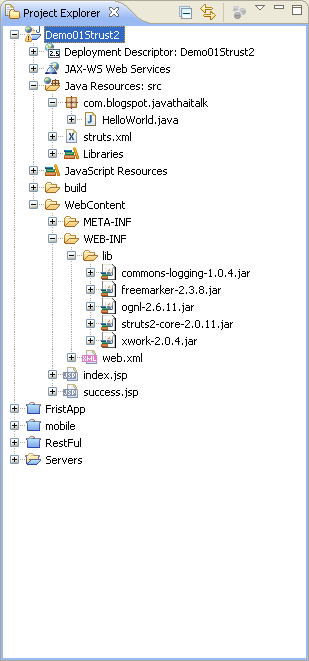ในแบบฝึกหัดนี้เราจะแสดงให้เห็นถึงวิธีการสร้าง Strust 2 แบบง่ายๆ ด้วย Hello World Application ก่อนการสร้างจะมีไฟล์ที่ประกอบการทำ Application ตามข้อมูลด้านล่างเลยครับ.
ไฟล์หลักๆ ในการทดสอบ Hello World Application
- web.xml
- struts.xml
- HelloWorld.java
- index.jsp
- success.jsp
รูปด้านล่างแสดงโครงสร้างของ Hello World Application
web.xml
<filter>
02.<filter-name>struts2</filter-name>
03.<filter-class>org.apache.struts2.dispatcher.FilterDispatcher </filter-class>
04.</filter>
05.<filter-mapping>
06.<filter-name>struts2</filter-name>
07.<url-pattern>/*</url-pattern>
08.</filter-mapping>
09.<welcome-file-list>
10.<welcome-file>index.jsp</welcome-file>
11.</welcome-file-list>
struts.xml
1.<struts>
2.<package name="default" extends="struts-default">
3.<action name="HelloWorld" class="com.blogspot.javathaitalk.HelloWorld">
4.<result name="SUCCESS">/success.jsp</result>
5.</action>
6.</package>
7.</struts>
index.jsp
01.<%@taglib uri="/struts-tags" prefix="s" %>
02.
03.<html>
04.<head>
05.<title>Hello World</title>
06.</head>
07.<body>
08.<s:form action="HelloWorld" >
09.<s:textfield name="userName" label="User Name" />
10.<s:submit />
11.</s:form>
12.</body>
13.</html>
HelloWorld.java
01.public class HelloWorld {
02.
03.private String message;
04.
05.private String userName;
06.
07.public HelloWorld() {
08.}
09.
10.public String execute() {
11.setMessage("Hello " + getUserName());
12.return "SUCCESS";
13.}
14.
15.public String getMessage() {
16.return message;
17.}
18.
19.public void setMessage(String message) {
20.this.message = message;
21.}
22.
23.public String getUserName() {
24.return userName;
25.}
26.
27.public void setUserName(String userName) {
28.this.userName = userName;
29.}
30.
31.}
ขันตอนของการ execute() method ของ class HelloWorld เราสามารถเข้าถึงข้อมูลของ properties ได้จาก Class นี้ซึ่งต่างจาก Struts 1 ที่ต้องมี Form. เราสามารถทำ Java class action ได้ง่ายๆ.
success.jsp
สำหรับ หน้า success เราจะทำการแสดงข้อความ "Hello คนไทย" โดยที่มันจะแสดงผ่าน property tag ที่ชื่อว่า message ด้านล่าง.
01.<%@taglib uri="/struts-tags" prefix="s" %>
02.<html>
03.<head>
04.<title>Hello World</title>
05.</head>
06.<body>
07.<h1><s:property value="message" /></h1>
08.</body>
09.</html>

* ถ้าใครต้องการ demo application ให้ comment และฝาก email ไว้นะครับ ผมจะส่งให้ทาง email.







